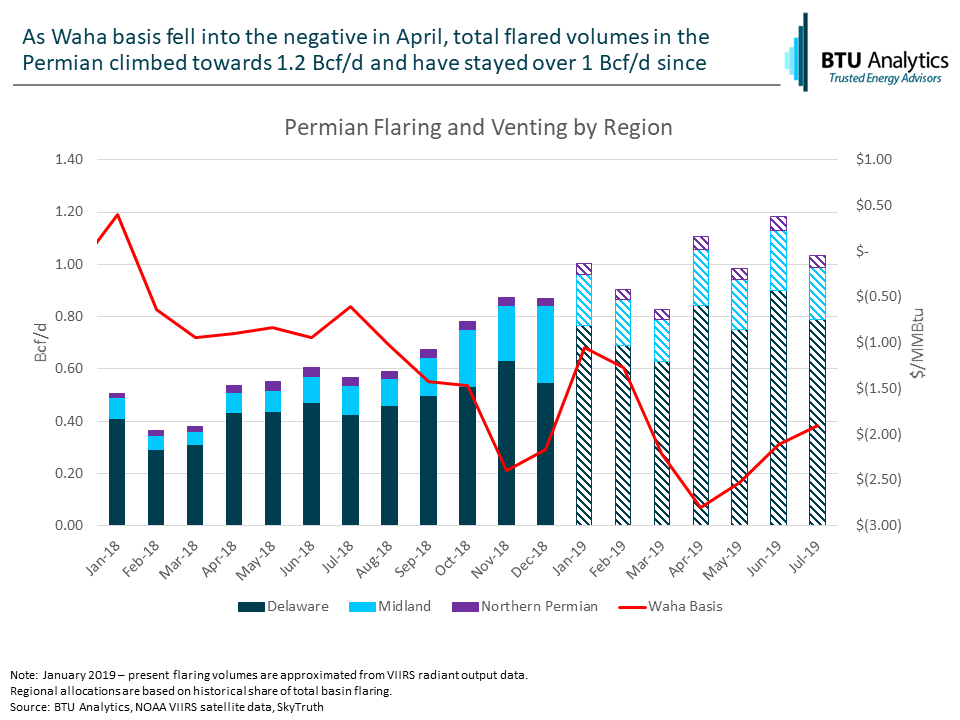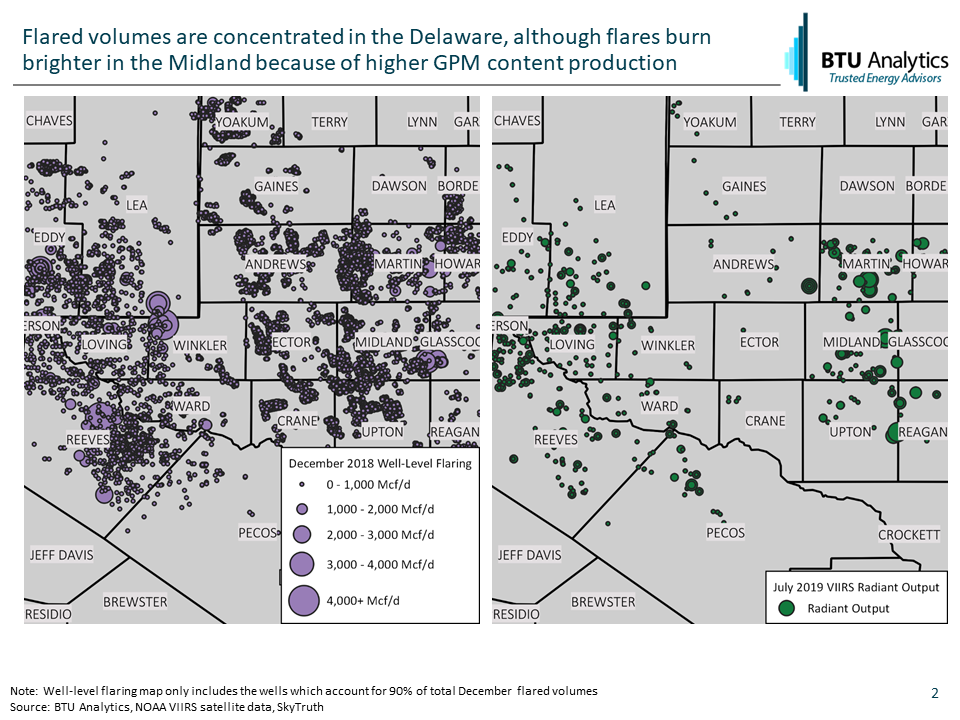Over one year ago, BTU Analytics posed the question: Should We Be Caring About Permian Flaring? Indeed we should: according to BTU Analytics’ Permian basin flaring model, total flaring in the Permian surpassed 1 Bcf/d in January. Since January, flared volumes have since continued to climb to over 1.2 Bcf/d in June. At current levels, nearly 10% of total Permian gross gas production is being flared. As Waha outright prices plummeted into the negative multiple times in the past six months, flared volumes increased in tandem. With Gulf Coast Express still a few months away, what can we expect from flaring in the Permian before its in-service date?
BTU Analytics’ Permian basin flaring model uses NOAA VIIRS data as aggregated by SkyTruth. BTU leverages the relationship between radiant output data from SkyTruth and well-level historical flaring volumes to estimate flaring volumes in recent months. By using well level flaring data, near term flared volumes can be estimated at a granular level and aggregated back up to regional estimates. Total flared volumes are concentrated in the Delaware Basin. In June, estimated flared volumes in the Delaware surpassed 0.9 Bcf/d exceeding the total flaring in the Permian in December. Flared volumes for July show a slight drop from peaks in June.
The chart below shows Permian flaring volumes by region versus Waha basis. As Waha basis blew out in April and outright pricing moved into negative territory, flaring increased across all of the Permian. Since the Permian is predominantly an oil play, most producers are indifferent to gas prices and are choosing to flare excess gas production rather than pay someone to take their gas or shut-in production.

According to BTU Analytics’ well level data, flaring volumes are highest in the Delaware. However, if you look at radiant output data, flares in the Midland burn the brightest. We can see this illustrated in the maps below which show well-level flared volumes and radiant output compared between December 2018 and July 2019.

Why are flares brighter in the Midland if flared volumes are higher in the Delaware? Midland gas production on average contains a higher heat content due to higher natural gas liquid yields in the Midland versus the Delaware. Thus, the gas produced and then flared in the the Midland burns brighter and at higher temperatures than the lower heat content production in the Delaware. Using both well-level production and radiant output data allows BTU Analytics to approximate region-level flared volumes in the Permian while considering differences across the basin like GPM content. The data also indicates a significant amount of natural gas liquids are going up in smoke along with the produced natural gas. Implying that as producers connect the natural gas to midstream infrastructure a new wave of natural gas liquids could hit the Gulf Coast in the fourth quarter of 2019.
The soonest relief valve for excess associated gas in the basin is Gulf Coast Express. Kinder Morgan announced Gulf Coast Express is running slightly ahead of schedule of the official October 2019 in-service date in their 2Q2019 earnings note last week. Kinder Morgan also recently announced their third natural gas pipeline from the Permian to the Texas Gulf Coast: the 2 Bcf/d Permian Pass project, but have not yet reached FID on this project. BTU Analytics expects Gulf Coast Express to fill quickly as operators capture flared volumes and producers with shut-in volumes bring wells online. This will provide some relief to staggering flaring volumes in the basin, but that relief is likely to be short-lived.
With infrastructure constraint relief not expected to arrive in the basin for a few more months, flaring is likely to remain in excess of 1 Bcf/d through the summer. To follow BTU Analytics’ forecasts for Permian basin flaring volumes, request a sample of our Upstream Outlook. For a deeper look at Permian gas production and basis dynamics, ask about the 3Q 2019 edition of our Gas Basis Outlook which will be published in August that will provide an updated view on the outlook for Waha and Midcontinent basis following the start of Gulf Coast Express and Midship Pipelines.









